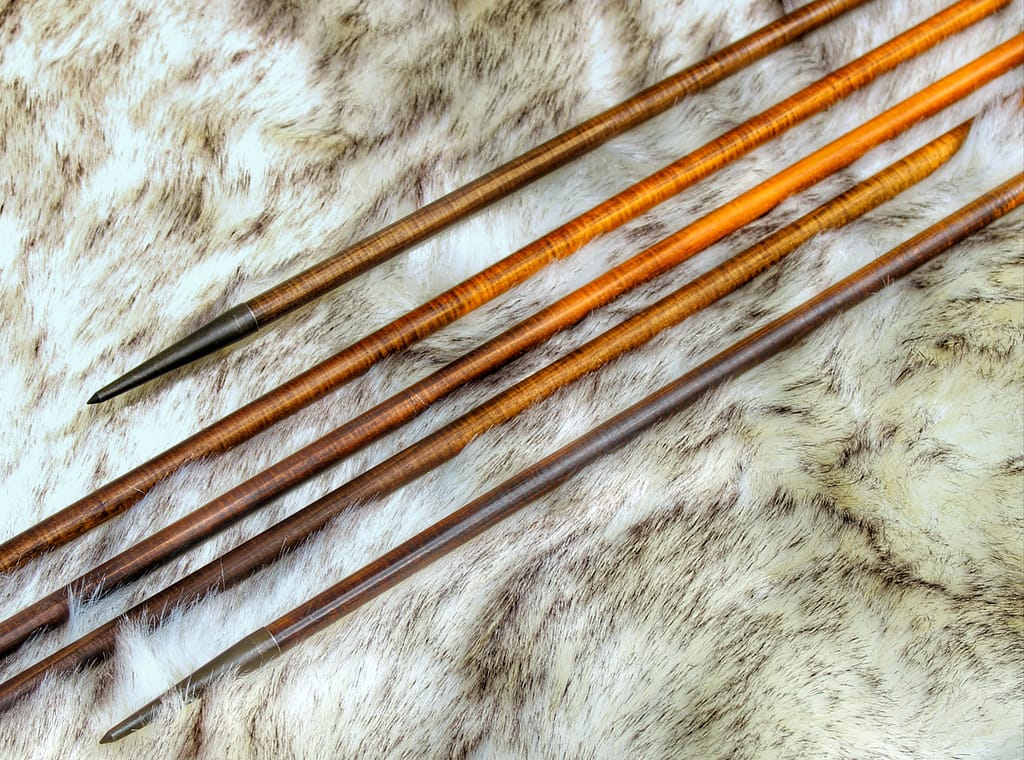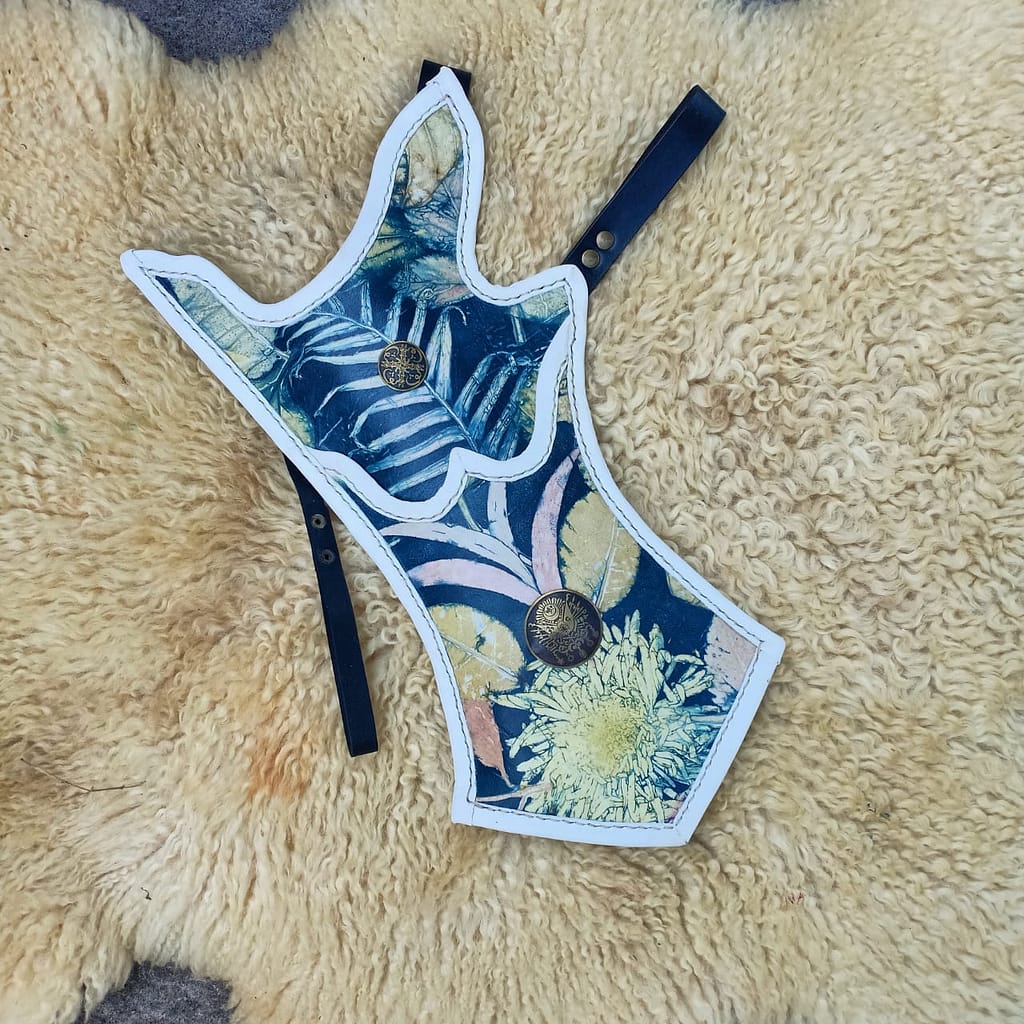Taking Care of Your Wood Arrows
How to ensure longevity from your Wooden Arrows.
Taking Care of Your Wood Arrows
Wood arrows are a vital part of traditional archery, with a history spanning centuries. Taking proper care of your wood arrows ensures not only their longevity but also their performance in flight. Understanding the nuances of maintaining wood arrows can enhance your shooting experience, minimize the risk of damage, and preserve their aesthetic appeal. This article will guide you through key steps to care for your wood arrows, from inspection to storage.
Before we start, I need to make 3 things very clear:
- ALWAYS check the integrity of your wood arrows before shooting them (do the tap test)
- NEVER shoot a compromised arrow, or an arrow showing any signs of damage
- ALWAYS err on the side of caution. It’s not worth the risk of severely hurting yourself.
Now, you might be asking; how do I ensure I don’t break my new wood arrows?
The truthful answer is; you can’t. Wood is a natural resource, and it’s not perfect. You will eventually break your wood arrows, but you can take steps towards ensuring they’re taken care of, and hopefully in doing so, you’ll ensure they have a long life in your quiver!
1. Regular Inspection and Maintenance
Taking care of wood arrows starts with a thorough and regular inspection. Proper maintenance not only ensures the longevity of the arrows but also prevents safety issues like splintering, which can occur over time.
Visual Inspection:
Before and after every shooting session, examine your wood arrows for signs of damage, including cracks, splinters, or warping. Even minor cracks can lead to larger issues if not addressed, making the arrow dangerous to shoot.
Additionally, check for any signs of impact damage that may have occurred if the arrow hit a hard surface or target.
Arrowhead and Nock Inspection:
Ensure that the arrowheads are securely attached and haven’t shifted during use. Loose arrowheads can cause inaccurate flight and may become hazardous. Similarly, check the nocks for any signs of cracking or wear. A damaged nock can affect string alignment and lead to misfires.
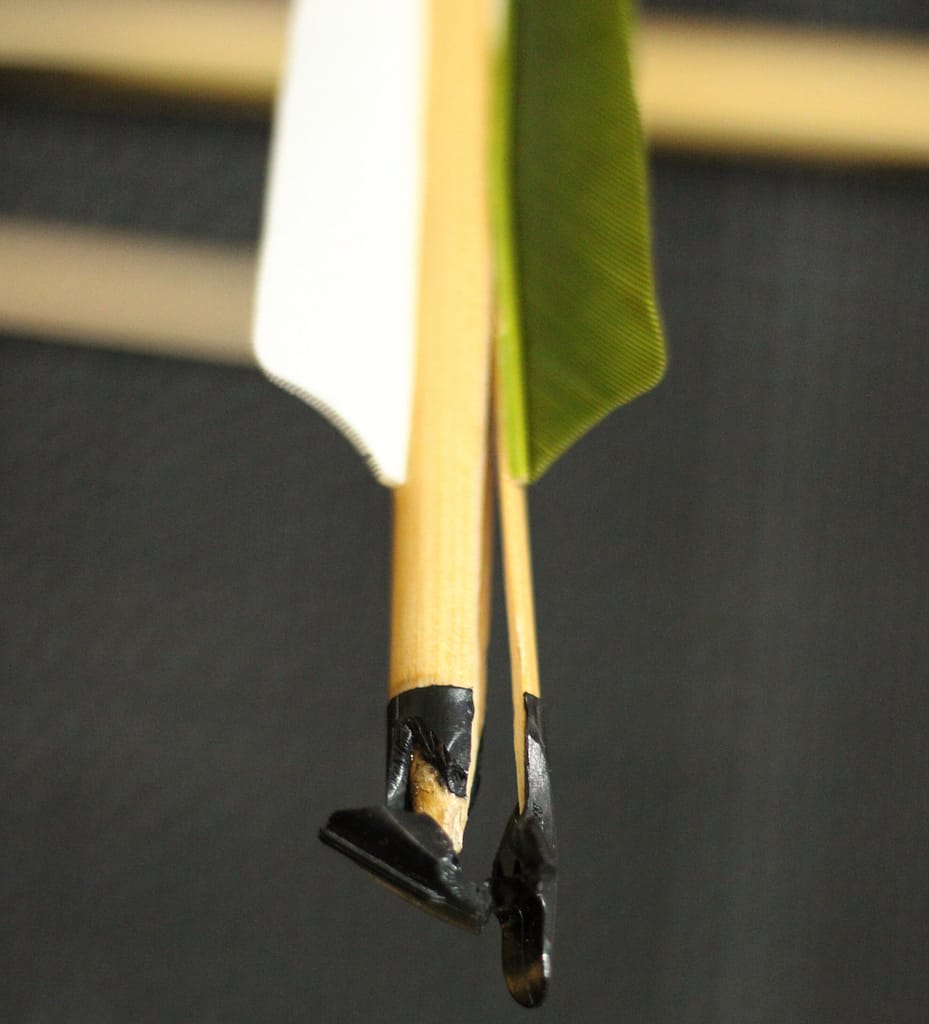
Straightness Check:
Over time, wood arrows can warp, particularly if exposed to moisture or extreme temperatures. To check for straightness, roll the arrow on a flat surface and watch for any wobbling. If the arrow doesn’t roll smoothly, it may be bent or warped. You can gently flex the arrow by hand to correct minor bends, but severely warped arrows should be replaced.
Bamboo arrows are slightly different, and although bamboo is generally ‘straight’, it doesn’t quite have the straightness that one would expect an arrow to have. Despite this, bamboo arrows fly incredibly straight & accurately, and straightening is less of an issue compared to Wooden arrows.
For those who are participating in traditional tourmaments, hunting trips, or other activities where accuracy is paramount, doing a ‘straightness check‘ every so often is important.
The Tap Test:
A critical and often overlooked step in arrow maintenance is the tap test. This method helps detect internal fractures that may not be visible to the naked eye. To perform the test, lightly tap the shaft of your arrow against your bow or the palm of your hand. Listen closely for any unusual sounds, such as dull thuds or rattles, which can indicate that the wood is beginning to splinter or crack internally.
- How to Perform the Tap Test:
Hold the arrow firmly by the nock and lightly tap the shaft along its length against your bow or hand. A healthy arrow will produce a sharp, consistent sound, while a damaged arrow may sound dull or uneven. If you hear anything unusual, it’s best to retire the arrow immediately, as it may break during flight, or worse, during firing.
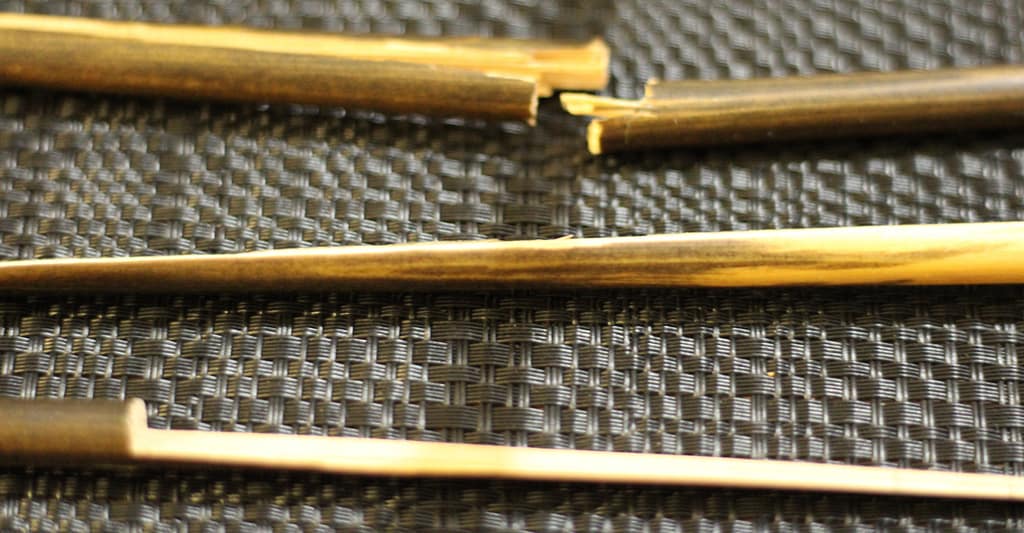
2. Protection from Environmental Elements
Humidity and Temperature: Wood is susceptible to changes in humidity and temperature, which can cause warping or cracking. Store your arrows in a dry, cool place to maintain their straightness and structural integrity. A humid environment can cause the wood to absorb moisture, making it heavier and less aerodynamic, while excessive heat can lead to drying and cracking.
Waterproofing: To protect wood arrows from moisture, we apply either Linseed Oil, or a lacquer finish. This helps us to create a protective barrier for our arrows that prevents water absorption and helps maintain the arrow’s weight and flight consistency.
3. Proper Storage Techniques
Arrow Quivers and Racks: Always store wood arrows in a quiver or rack that keeps them upright and prevents them from bending or becoming damaged. Avoid stacking arrows horizontally for long periods, as this can lead to warping.
Avoid Direct Sunlight: Exposure to direct sunlight can cause the wood to dry out, leading to cracks. Ensure that your arrows are stored in a shaded area when not in use.
Transport Care: During transport, use a hard case to protect the arrows from impact or crushing. A protective case ensures that your arrows stay in the best condition, even during long trips.
- Re-cap:
- Store arrows upright in quivers or racks.
- Keep arrows away from direct sunlight.
- Use a hard case for transporting arrows to prevent damage.
4. Cleaning and Polishing
Routine Cleaning: After each shooting session, clean your arrows to remove dirt, sap, or other debris that may affect performance. Use a soft cloth to gently wipe down the shaft, taking care not to damage the feathers or fletching.
Polishing: Polishing the shaft is unnecessary, as our arrows are already treated to provide an additional layer of protection. However, taking a microfiber cleaning cloth and lightly cleaning your arrows can work well. Don’t use any products or chemicals, and if you’ve got bare-wood arrows, you can use a natural oil – such as Linseed Oil – to provide some TLC to your arrows.
5. Turkey Feather Fletchings
Turkey feathers are a popular choice for traditional wood arrows due to their durability, natural aerodynamics, and historical use in archery. We exclusively use real turkey feathers, and never choose to use synthetic or plastic vanes for our arrows. However, these feathers require proper care to ensure they perform optimally and maintain their shape over time.
Inspecting Turkey Feather Fletching
Regular inspection is crucial for ensuring the feathers remain intact and properly aligned. After each shooting session, check the fletching for signs of wear, tears, or fraying. Damaged feathers can affect the flight of your arrows, leading to inaccuracies.
- Tip: Minor damage can sometimes be repaired by gently trimming frayed edges with small scissors. However, for more extensive damage, it’s best to replace the feather.
Reconditioning Turkey Feathers
Turkey feathers are more susceptible to moisture than synthetic options. Exposure to rain, humidity, or even heavy dew can cause the feathers to clump, lose their natural shape, or curl. If this happens, you can recondition the feathers using a simple steaming method:
- Steaming Feathers: Hold the feathers over a pot of steaming water (or your kettle) for a few seconds. The steam helps relax the feathers and allows them to regain their original shape. After steaming, gently stroke the feathers back into form using your fingers.
- Avoid Over-Steaming: Excessive heat can weaken the quill of the feather, so be careful not to over-steam. A few seconds of exposure is enough to reshape the fletching.
Protecting Turkey Feathers from Moisture
To minimize the effects of moisture on turkey feathers, you can use a silicone spray as waterproofing treatment. However I personally don’t, and don’t believe it to be overly useful. The natural feathers will do what they’re meant to, and using any type of spray can lead to issues down the road. If you are going to apply some kind of spray, make sure to use a light coat of water-repellent specifically designed for feathers or archery equipment.
- Note: Avoid using heavy waxes or oils, as they can weigh down the feathers and reduce their aerodynamic properties.
Storage to Protect Your Feather Fletchings
Proper storage is essential to maintaining the shape and longevity of turkey feathers. Store your arrows in a dry, cool place, away from direct sunlight or excessive humidity. When placing arrows in a quiver, ensure the fletching is not compressed to avoid bending or deforming the feathers.
Storage Summary
- Inspection: Check turkey feathers for fraying or damage.
- Reconditioning: Use steam to reshape feathers if they become bent or clumped.
- Waterproofing: Apply a feather-friendly water repellent to protect against moisture.
- Storage: Keep arrows in a dry environment and ensure the feathers are not compressed.
By paying close attention to the care of your turkey feather fletching, you can ensure that your wood arrows maintain their aerodynamic performance and traditional appeal.
Conclusion
Taking care of wood arrows is essential for maintaining their performance and extending their lifespan. By regularly inspecting and maintaining them, protecting them from environmental factors, and storing them properly, you can ensure that your wood arrows remain in excellent condition for years to come.
Summary:
- Regular Inspection: Check for cracks, straightness, and secure fittings. Do the tap-test
- Environmental Protection: Store arrows in a cool, dry place and avoid chemical polishes.
- Proper Storage: Use quivers or racks, avoid direct sunlight, and protect arrows during transport.
- Cleaning and Polishing: Keep arrows clean and avoid chemical polishes, only use natural oils when necessary.
- Fletching Maintenance: Regularly check and restore feathers. Use the steam method!
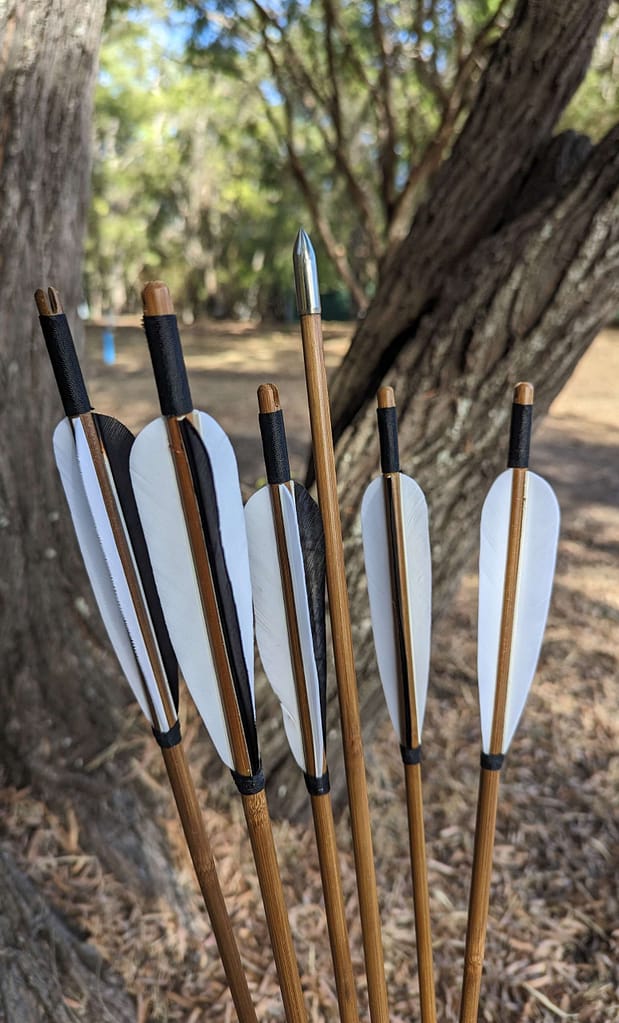
From The Author
Taking care of your wood arrows is not just about preserving your equipment—it’s about respecting the craft and connecting with your equipment and the rich history of Archery. Whether you’re a seasoned archer or new to traditional gear, proper maintenance ensures your arrows fly true and last through many shooting sessions.
This article complements my previous discussions on historical archery. If you’re intrigued by how archery evolved across different cultures, you might enjoy my article on Traditional Turkish Archery, specifically the Ottoman Empire, which delves into the fascinating historical context, techniques, and craftsmanship behind one of the most advanced bow designs in history.
I also explore the critical differences between the longbows found in Europe and the Asiatic bows from the east in another piece, offering a comparative look at these iconic weapons and their uses in historical warfare.
